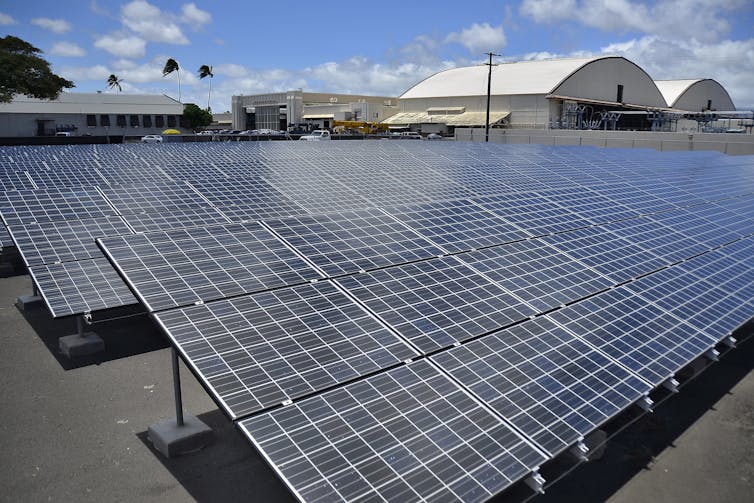Climate change is about to play a big role in government purchases – with vast implications for the
The Biden administration directed agencies to consider the cost of greenhouse gas emissions in their future purchasing and budget decisions. An example shows just how much is at stake.

Each year, the federal government purchases about 50,000 new vehicles. Until recently, almost all of them ran on diesel or gasoline, contributing to U.S. demand for fossil fuels and encouraging automakers to continue focusing on fossil-fueled vehicles.
That’s starting to change, and a new directive that the Biden Administration quietly issued in September 2023 will accelerate the shift.
The administration directed U.S. agencies to begin considering the social cost of greenhouse gases when making purchase decisions and implementing their budgets.
That one move has vast implications that go far beyond vehicles. It could affect decisions across the government on everything from agriculture grants to fossil fuel drilling on public lands to construction projects. Ultimately, it could shift demand enough to change what industries produce, not just for the government but for the entire country.
What’s the social cost of greenhouse gas?
The social cost of greenhouse gases represents the damage created by emitting 1 metric ton of carbon dioxide, methane and other greenhouse gases into the atmosphere.
These greenhouse gases, largely from fossil fuels, trap heat in the atmosphere, warming the planet and fueling climate change. The result is worsening storms, heat waves, droughts and other disasters that harm humans, infrastructure and economies around the world. The estimate is intended to include changes in agricultural productivity, human health, property damage from increased flood risk, and the value of ecosystem services.
By directing agencies to consider those costs when making purchases and implementing budgets, the administration is making it more likely that agencies will purchase products and make investments that are more energy efficient and less likely to fuel climate change.

While only a fraction of the roughly $6 trillion that the U.S. government spends each year would likely be considered under the new directive, that fraction could have far-reaching impacts on the U.S. economy by reducing demand for fossil fuels and lowering emissions across sectors.
Estimating the cost
The Obama administration introduced the first federal social cost of carbon to incorporate climate risk in regulatory decisions. It’s calculated using models of the global economy and climate and weighs the value of spending money today for future benefits.
When the Trump administration arrived, it cut the estimated cost from around $50 per metric ton to less than $5, which justified rolling back several environmental regulations, including on power plant emissions and fuel efficiency. The Biden administration restored an interim price to about $51, with plans to raise it.
Recent research suggests that the actual social cost of carbon is closer to $185 per metric ton. But carbon dioxide is just one greenhouse gas. The new directive takes other greenhouse gases into consideration, too – in particular, methane, which has about 80 times the warming power of carbon dioxide over 20 years.
Estimates of the social cost of methane, which comes from livestock and leaks from pipelines and other natural gas equipment, range from $933 per metric ton to $4,000 per metric ton.

Without directives like these, decision-makers implicitly set the cost of greenhouse gas emissions to zero in their benefit-cost analyses. The new directives allow agencies to instead compare the expected climate damages, in dollars, when making decisions about vehicle purchases, building infrastructure and permitting, among other choices.
The vehicle fleet as an example
The federal vehicle fleet is a good example of how the social costs of greenhouse gases add up.
Let’s compare the costs of driving an electric Ford Focus and an equivalent conventional-fuel Ford Focus.
Assume each vehicle drives an average of 10,000 miles (about 16,000 kilometers) per year – that’s less than the U.S. average per driver, but it’s a simple number to work with. The damages from emissions in dollars from driving a conventional Ford Focus 10,000 miles are between $133 and $484, depending on whether you use a social cost of carbon of $51 per metric ton or $185 per metric ton.
The climate harm from driving an equivalent electric Ford Focus 10,000 miles, based on the average carbon dioxide emissions intensity from the U.S. electricity grid, would be between $59 and $212, using the same social costs.
Scale that to 50,000 new vehicle purchases, and that’s a cost difference of about $4 million to $13.5 million per year for emissions from operating the vehicles. While producing an EV’s battery adds to the vehicle’s emissions up front, that’s soon outweighed by operational savings. These are real savings to society.
The U.S. government is also a major consumer of energy. If agencies begin to consider the climate damages associated with fossil energy consumption, they will likely trend toward renewable energy, further lowering their own emissions while boosting the burgeoning industry.
How the government can shift demand
These types of comparisons under the new directive could help shift purchases toward a wide range of less carbon-intensive products.
Much of the U.S. government’s spending goes toward carbon-intensive goods and services, such as transportation and infrastructure development. Directing agencies to consider and compare the social cost of purchases in each of these sectors will send similar signals to different segments of the market: The demand for less carbon-intensive goods is rising.
Because this new directive expands to other greenhouse gases, it could have broad implications for new permitting for oil and gas development and agricultural production, as these are the two largest sources of methane in the U.S.
While this decision is not a tax on carbon or a subsidy for less carbon-intensive goods, it will likely send similar market signals. With respect to purchases, this policy is akin to tax rebates for energy efficient products, like electric vehicle incentives in the Inflation Reduction Act, which boost demand for EVs.
Ultimately, if one of the largest segments of demand, the U.S. government, transitions to less carbon-intensive products, supply will follow.
Jesse Burkhardt receives funding from the USDA and Department of the Interior.
Lauren Gifford does not work for, consult, own shares in or receive funding from any company or organization that would benefit from this article, and has disclosed no relevant affiliations beyond their academic appointment.
Read These Next
How the ‘slayer rule’ might play a role in determining who will inherit wealth from Rob Reiner and h
These rules have a long history in the United States. They played a role in the notorious murders by…
The celibate, dancing Shakers were once seen as a threat to society – 250 years later, they’re part
‘The Testament of Ann Lee,’ Mona Fastvold’s 2025 film, depicts part of the long history of Shaker…
From truce in the trenches to cocktails at the consulate: How Christmas diplomacy seeks to exploit s
World leaders like to talk up peace at Christmastime. But alongside the tales of seasonal breaks in…






